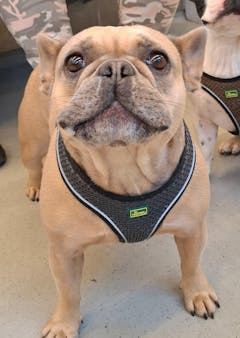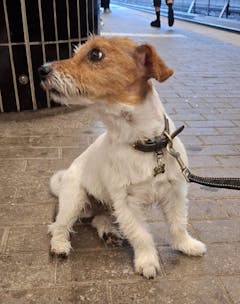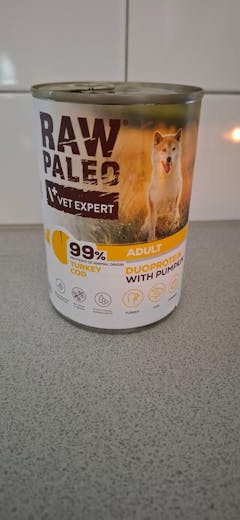Trimning & Klippning
Hundprodukter > Pälsvård & Klor > Trimning & Klippning
Trimning & Klippning för Hund och Katt: Skapa en Professionell Look Hemma
En välvårdad päls är inte bara vacker att se på; den är också avgörande för ditt husdjurs hälsa och komfort. För många hund- och kattraser är regelbunden **trimning och klippning** en nödvändig del av **pälsvården**. Det hjälper till att bibehålla pälsens funktion, förebygga tovor, minska fällning och säkerställa att ditt husdjur mår bra. På Zoostar.se har vi samlat ett omfattande sortiment av högkvalitativa verktyg och tillbehör för **trimning & klippning**, så att du kan ge din pälskling en professionell pälsvårdsupplevelse i hemmiljö.
Oavsett om du behöver en kraftfull **hundtrimmer** för tjock päls, en precisionssax för detaljarbete, eller en **trimkniv** för handtrimmade raser, hittar du de rätta produkterna hos oss. Vi erbjuder allt från nybörjarvänliga kit till avancerade verktyg för den erfarna hemmafrisören, med fokus på säkerhet, effektivitet och komfort för både djur och ägare. Att lära sig grunderna i **klippning av hund** eller **trimning av katt** kan spara dig både tid och pengar, samtidigt som det stärker bandet mellan dig och ditt husdjur.
I den här guiden går vi igenom varför **trimning & klippning** är så viktigt, vilka verktyg som är bäst för olika pälstyper, och hur du utför en säker och effektiv trimning i hemmet. Vi kommer också att belysa hur dessa rutiner samverkar med andra aspekter av **pälsvård & klor** för att säkerställa att din pälskling alltid ser ut och mår som bäst.
Varför Trimning & Klippning Är Essentiellt
**Trimning och klippning** är mer än bara en fråga om estetik; det är en kritisk del av ditt husdjurs hälsa och hygien.
1. Förebygger Tovor och Hudproblem:
- Långhåriga raser: Lång päls, om den inte trimmas och borstas regelbundet, kan lätt bilda tovor och mattor som drar i huden, orsakar smärta och kan leda till hudirritationer, sår och infektioner.
- Fukt och smuts: En kortare, välskött päls samlar mindre smuts och torkar snabbare efter regn eller bad, vilket minskar risken för fukteksem och svampinfektioner.
2. Temperaturreglering:
- Sommar: För raser med tjock päls kan en kortare klippning hjälpa dem att hålla sig svalare under varma sommarmånader och förebygga överhettning.
- Vinter (vissa raser): Vissa pälsar kan bli för långa och samla snö och is på vintern. En vältrimmat päls kan vara mer praktisk.
3. Hygien:
Att hålla pälsen kortare runt tassar, under magen och runt analöppningen förbättrar hygienen, minskar risken för att smuts fastnar och underlättar rengöring.
4. Komfort och Rörlighet:
Lång päls som hänger för ögonen kan hindra synen, och lång päls mellan trampdynorna kan göra det svårt för hunden att få fäste och gå bekvämt.
5. Minskar Fällning:
För raser som klipps, kan regelbunden klippning bidra till att minska mängden fällande hår i hemmet.
Viktiga Verktyg för Trimning & Klippning
Att ha rätt verktyg är halva jobbet när det gäller **trimning och klippning**. På Zoostar.se hittar du ett komplett utbud:
1. Hundtrimmers / Klippmaskiner:
- Elektriska klippmaskiner: Finns i olika styrkor och hastigheter. En bra **hundtrimmer** är tystgående och har utbytbara skär som passar olika pälstyper.
- Sladdlösa/Batteridrivna: Ger större flexibilitet och rörlighet, bra för att klippa svåråtkomliga områden.
- Skär och kammar: Olika skärstorlekar och distanskammar (påsatser) bestämmer klipplängden. Det är viktigt att ha vassa skär för att undvika att dra i pälsen.
- Passar för: Pudel, Bichon Frisé, Cocker Spaniel, Shitzu och andra raser som klipps jämnt över kroppen.
2. Saxar för Pälsvård:
- Rak sax: För grundläggande klippning och längdjustering.
- Effileringssax / Urtunningssax: Har tandade blad som tar bort en del av pälsen vid varje klipp, vilket skapar en mjukare övergång och tunnar ut tjocka områden. Utmärkt för att forma och blanda päls.
- Rundad sax: Med rundade spetsar för säker klippning runt känsliga områden som ögon, öron och tassar. Ett måste för nybörjare.
- Passar för: Alla raser, för detaljarbete, formning och finishing.
3. Trimknivar (Stripping Knives):
- Utseende: Har en tandad bladkant och handtag. Används för att "rycka" ut död päls.
- Användningsområde: För handtrimmade raser (strävhåriga) för att bibehålla pälskvaliteten och texturen. Den döda pälsen rycks ut istället för att klippas.
- Passar för: Terrier, Schnauzer, Strävhårig tax, Cairn Terrier.
4. Tillbehör:
- Kylspray för skär: Håller skären svala under klippning och minskar slitage.
- Skärolja: Smörjer skären och håller dem vassa och effektiva.
- Rengöringsborste: För att rengöra skär och klippmaskiner.
- Pälsklämmor/gummiband: För att dela upp pälsen och underlätta klippningen.
- Bord för trimning: Ett stadigt trimningsbord med galge gör arbetet säkrare och mer bekvämt.
Trimning & Klippning: Steg-för-Steg Guide Hemma
Att trimma eller klippa ditt husdjur hemma kräver tålamod och förberedelse. Följ dessa steg för ett säkert och effektivt resultat:
1. Förbered Ditt Husdjur:
- Borsta och red ut: Detta är det absolut viktigaste steget! En smutsig eller tovig päls kan skada klippmaskinen och orsaka obehag för djuret. Borsta igenom pälsen noggrant med en kardborste eller kam för att avlägsna tovor och lös päls.
- Bada och torka: För de flesta raser är det bäst att klippa en ren, torr päls. Bada hunden med ett passande hundschampo och se till att pälsen är *helt* torr innan du börjar klippa.
- Lugn miljö: Välj en lugn plats med bra belysning där ditt husdjur känner sig tryggt.
2. Förbered Verktygen:
- Rengör och olja: Se till att klippmaskinen är ren, oljad och att skären är vassa. En slö maskin drar i pälsen.
- Ha allt nära till hands: Lägg fram alla saxar, kammar, kylspray, olja och handdukar du kan tänkas behöva.
3. Klippning / Trimning:
- Börja försiktigt: Börja med en låg inställning på klippmaskinen och en längre distanskam om du är osäker. Det är lättare att ta bort mer päls än att lägga till.
- Klipp i pälsens riktning: För de flesta klippmaskiner klipps pälsen bäst i dess växtriktning för ett jämnare resultat.
- Spänn huden: Håll huden spänd med din fria hand för att undvika att skära i veck.
- Var försiktig vid känsliga områden: Var extra noga runt ögon, öron, trampdynor och könsorgan. Använd en **sax med rundade spetsar** för dessa områden.
- Korta pauser: Om ditt husdjur blir stressat, ta korta pauser. Belöna med godis och lugnande ord.
- Trimning med trimkniv: För strävhåriga raser, använd trimkniven för att rycka ut död päls. Arbeta i små sektioner och ryck alltid i pälsens växtriktning. Detta är en teknik som kan kräva övning eller handledning från en professionell.
4. Efter Klippningen:
- Rengör: Borsta bort lösa hår och rengör klippmaskinen och saxarna noggrant. Olja in skären på klippmaskinen.
- Belöna: Ge ditt husdjur rikligt med beröm, lek och en extra godbit för att de har varit så duktiga.
- Inspektera: Kontrollera att det inte finns några sår eller irritationer på huden.
- En sista touch: Avsluta gärna med en fräsch husdjursparfym.
Trimning & Klippning i Zoostars Totala Pälsvårdsfilosofi
På Zoostar.se ser vi **trimning & klippning** som en central del av en omfattande **pälsvårdsrutin**. Dessa verktyg och rutiner samverkar med flera av våra andra kategorier för att skapa en helhetslösning för din hunds eller katts välbefinnande.
- Pälsvård & Klor: Trimning och klippning är en integrerad del av den dagliga pälsvården, som syftar till att bibehålla en frisk och funktionell päls.
- Bad & Hygien: En ren och torr päls är grundläggande för en lyckad klippning. Se vårt utbud av hundschampo och balsam som förbereder pälsen optimalt.
- Husdjursparfym: Används ofta som en avslutning efter en klippning för att ge din pälskling en fräsch och behaglig doft.
- Borstar & Kammar: Oumbärliga för att förbereda pälsen inför klippning, genom att reda ut tovor och avlägsna lös päls, samt för att jämna ut resultatet efteråt.
- Klovård: Eftersom lång päls runt tassarna kan påverka klornas hygien och växt, är klippning av tasspälsen en viktig del av den övergripande **klovården**.
- Husdjurshygien & Våtservetter: Praktiska för att rengöra klippmaskinen från hår, torka av ditt husdjur under pauser eller för att rengöra efter en klippning.
På Zoostar.se är vårt mål att erbjuda dig de bästa **hundprodukter** och **kattprodukter** som främjar ditt husdjurs hälsa, komfort och enastående utseende. Med vårt sortiment för **trimning & klippning** kan du känna dig trygg i att du har de verktyg som behövs för att ge din pälskling den bästa omvårdnaden hemma. Utforska våra produkter idag och upplev glädjen av en välvårdad och lycklig hund eller katt!
Vanliga Frågor om Trimning & Klippning för Husdjur (FAQ)
Hur ofta ska jag trimma/klippa min hund eller katt?
Frekvensen beror på ras, pälstyp, pälsens växttakt och önskad längd. Hundar som klipps jämnt (t.ex. Pudel) kan behöva klippas var 4-8 vecka. Strävhåriga raser som handtrimmas behöver oftast trimmas 2-4 gånger per år. Katter behöver sällan klippas om de inte har tovor eller medicinska behov, men vissa långhåriga raser kan gynnas av regelbunden trimning för att undvika tovor. Håll ett öga på pälsen och agera när den börjar tova sig eller bli för lång.
Kan jag använda en människotrimmer eller sax på mitt husdjur?
Nej, det rekommenderas starkt att endast använda **klippmaskiner och saxar** som är speciellt designade för husdjur. Människotrimmers är oftast inte kraftfulla nog för djurpäls, vilket kan leda till att de drar och sliter i pälsen, vilket är smärtsamt för djuret och kan skada maskinen. Djurklippare är också tystare och vibrerar mindre, vilket är viktigt för att hålla djuret lugnt. Hundsaxar är också utformade med blad som är säkra och effektiva för djurpäls.
Min hund hatar klippmaskinen. Vad kan jag göra?
Börja med att vänja hunden vid ljudet och känslan av klippmaskinen när den är avstängd. Sedan, slå på den utan att röra hunden, belöna. Nästa steg är att låta den vibrera mot en liten del av kroppen, t.ex. en tass, för en kort stund. Ge mycket godis och beröm. Öka gradvis tiden och klippområdet. Se till att **klippmaskinen** är tystgående och inte drar i pälsen. Om hunden är mycket stressad, kan professionell hjälp eller en lugnande spray (husdjursparfym kan ha lugnande dofter) vara ett alternativ.
Hur undviker jag att skära mitt husdjur under klippning?
Var alltid extremt försiktig. Håll huden spänd och platt när du klipper. Använd en kam för att lyfta pälsen och klipp bara det som sticker ut. Använd **saxar med rundade spetsar** runt känsliga områden som ögon, öron och tassar. Var medveten om var hudveck och utskjutande ben är. Om du är osäker, klipp hellre lite i taget än för mycket, och ta korta pauser för att lugna dig själv och djuret.
Vilken klippmaskin är bäst för tjock, tovig päls?
För tjock eller tovig päls behöver du en kraftfull **klippmaskin** med en stark motor och vassa, hållbara skär. En professionell modell med hög varvtalskapacitet är att föredra. Se till att pälsen är väl genomborstad och fri från tovor *före* klippning; annars kan även den bästa maskinen fastna och dra i pälsen. Att först använda en tovutredare kan vara nödvändigt.
Behöver katter klippas eller trimmas?
De flesta katter behöver inte klippas regelbundet om de inte har lång päls som tovar sig lätt eller har medicinska tillstånd som gör att de inte kan sköta sin egen päls. Långhåriga katter som Perser och Maine Coon kan behöva professionell trimning eller en lätt klippning för att förebygga tovor, särskilt under varma månader. För katter är det extra viktigt att klippningen sker i en lugn miljö med vana händer, då de lätt blir stressade. Se vårt sortiment av borstar och kammar som kan hjälpa till att minimera behovet av klippning genom regelbunden pälsvård.
] }Husdjursprodukter Online
Utforska fler populära hundkategorier
Här hittar du många av våra mest efterfrågade kategorier – från hundfoder och godis till tillbehör, vård och aktivering.
Ledande Fodertillverkare
Populära hundfodermärken
Här hittar du våra mest populära hundfoder – från spannmålsfritt till veterinärfoder. Klicka på ett varumärke för att se hela sortimentet.






